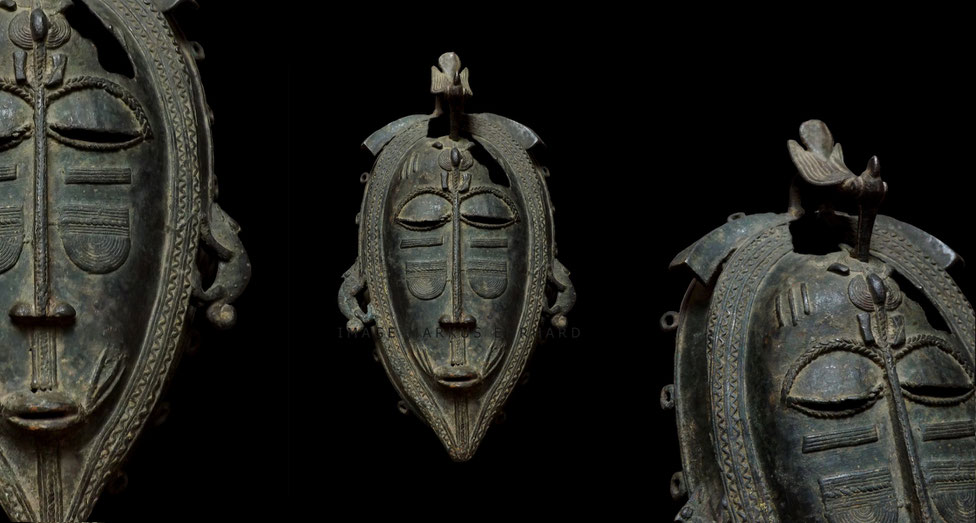
Beside the Koulé (Senufo cavers who work with wood) and the Fono (Senufo smithers who work with wood), there is the professional group of the Loko, smithers who cast metal. It is not explicit clarified that the group of Fono separated from the Loko. Loko were also merchants, who travelled around to sell their objects like Tugubele and Nyingife statues, jewelry and masks. Lokos lived in the area of the Gbato and Kafibele Senufo of Bolopé in the north, Ouézomon in the south and Sirasso in the east of Ivory Coast. Also a group living in Korhogo, working for Airport-art objects, are known (from Kunst und Religion bei den Gbato-Senufo, Elfenbeinküste, Karl-Heinz Krieg und Wulf Lohse, Im Selbstverlag, Hamburg 1981, page 52).
Kpelié masks made by a Loko are larger and different in decorating elements comparing to masks made by a Fono. Loko metal masks are closer to the classic Kpelié carved in wood. A typical sign for a work of a Loko are the casted rings surrounding the back of the mask. These attachments where formed in wax one after another. These rings also work as decorating elements. Sometimes these rings are not fully casted. Generally Kpelié masks from a Loko are extremely thin and show a complex buildup in the back. Diverse frames set up the mask around the oval shaped face. At the edge of the last frame there are rings to fix the mask on a piece of cloth.
Loko masks are famous for showing very fine threads made of wax in their mockups. These threads can be placed waved, rolled, twisted or braided. The presented mask above is a very good example showing all these various techniques in perfection. This Kpelié, collected by Karl-Heinz Krieg in Sirasso, represents all the protozoans of the Senufo: The python (symbolized throught the waved lines framing the face), the turtle (in the middle of the forehead), the Calao bird (above the turtle touching the forehead with his peg), and the two chameleons on each side of the mask.
Unfortunately the right part of the forehead is not fully casted and shows gaps and wholes. The cast is very fine detailed and extremely slim, some parts are less than 1 mm thin, almost like tin plate. The greenish patina is to describe as authentic for a very old mask of the Loko artisans.
Kpelié mask, casted by a Loko artisan. Collected by Karl-Heinz Krieg in Sirasso.
25,0 x 13,5 x 9,5 cm, bronze alloy.
Literature:
- Wenn Brauch Gebrauch beeinflusst, Markus Ehrhard, page 126 - 127.
- Wenn Urform Form bestimmt, Markus Ehrhard, page 172.
- Kunst und Religion bei den Gbato-Senufo, Elfenbeinküste, Karl-Heinz Krieg und Wulf Lohse, Im Selbstverlag, Hamburg 1981, page 52.
Copyright content and images by Markus Ehrhard

